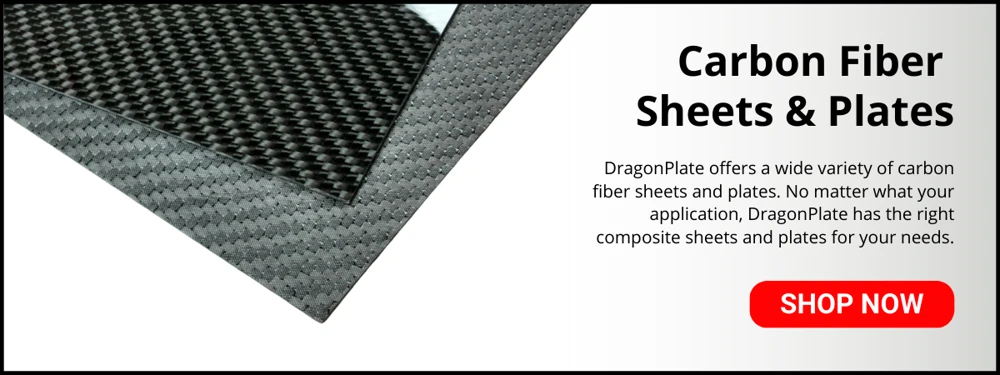Carbon Fiber 101: What do Isotropic, Quasi-Isotropic, and Anisotropic Mean?
When working with carbon fiber, which is known for its remarkable strength and stiffness to weight ratio, one needs to understand how fiber orientation factors into the strength and stiffness of a carbon fiber reinforced plastic (CFRP) laminate. There are different approaches to laminate design for composite panels, the laminates of which are angularly oriented to yield different structural properties. These properties are: isotropic, quasi-isotropic, and anisotropic.
Isotropic means a material with strength and stiffness that are the same when measured in any direction through that material. Examples of isotropic substances are glass and metals.
Quasi-isotropic means a material having isotropic properties, but only in-plane. In other words, the strength and stiffness are equal in all directions within the plane of the part. Many CFRP laminates fall within this category.
Anisotropic means a material with different strength and stiffness in different directions through the material. For example, wood is stronger along the grain than across it. Carbon fiber laminates made with the fibers all oriented in one direction are extremely anisotropic. Other laminate designs can have various degrees of anisotropy depending on how balanced the laminate design is.
Fabricating Quasi-Isotropic Carbon Fiber Laminates
/Quasi%20isotropic%20carbon%20fiber%20manufactured%20in%20cny.png) CFRP laminates have Quasi-isotropic properties when the orientation of the fibers in the layup are balanced resulting in constant strength and stiffness of the material regardless of the direction in which it is loaded. Whether the individual carbon fiber plies or lamina are made from woven fabric or unidirectional carbon fiber, they can be assembled to create an isotropic material when combined in a well designed laminate stack.
CFRP laminates have Quasi-isotropic properties when the orientation of the fibers in the layup are balanced resulting in constant strength and stiffness of the material regardless of the direction in which it is loaded. Whether the individual carbon fiber plies or lamina are made from woven fabric or unidirectional carbon fiber, they can be assembled to create an isotropic material when combined in a well designed laminate stack.
Quasi-isotropic laminates are made when the orientations of the plies are balanced so that the extensional stiffness of the laminate is the same in each in-plane direction. Typically, quasi-isotropic sheets are created using carbon fiber weaves with plies oriented at 0º, 90º, +45º, and -45º, with at least 12.5% of the plies in each of these four directions. Quasi-isotropic properties can be reached with 0º, 60º, and 120º-oriented unidirectional plies as well.
It is possible for a laminate to be quasi-isotropic and not seem to follow the rules. For example, a 0º/-45º/+45º/90º laminate, as noted above, is quasi-isotropic. However, if each layer is oriented at the same angle from its original orientation (for example, +60º), the laminate remains isotropic. The reorientation of the laminate by +60º creates a 60º/15º/-75º/-30º laminate.
In addition to orientation angles, there are other design requirements for a quality carbon fiber laminate:
- The layup must be symmetrical.
- In addition, each lamina would typically:
- Contain the same fiber-resin ratio;
- Have the same layer thickness;
- Contain the same fiber type and geometry
In more complex designs, these rules may not apply
Quasi-Isotropic Carbon Fiber Sheet Design
In a typical quasi-isotropic carbon fiber sheets, the sheet must contain at least 4 layers, and the individual layers must contain identical stiffness and thicknesses. Furthermore, the fiber orientation must be balanced and symmetrical. In addition to working together to provide quasi-isotropic properties, the fibers at different orientations also provide specific strengths:
- 0º layers: Provide axial strength and stiffness that is ideal for beams and columns that must resist axial loads.
- +/- 45º layers: Provide shear and torsional strength and stiffness that is ideal for torsion shafts and shear webs such as I-beam webs.
- 90º layers: Provide transverse strength and stiffness that is ideal for creating a consolidating layer that keeps everything together and provides strength in pressure vessels.
Quasi-Isotropic Advantages
It is possible to manufacture carbon fiber sheets less expensively by not using a quasi-isotropic layup. For instance, if only 0- and 90-degree carbon fiber layers are used to build the laminate, the laminate will be weak along the 45-degree diagonal and the deflections in off-axis bending and tension are up to 50% higher compared to quasi-isotropic carbon fiber plates. For most applications, 0º/90º sheets will work very well. However, if stiffness along the 45-degree axis is necessary, quasi-isotropic carbon fiber sheets would offer superior performance. Quasi-isotropic carbon fiber sheets can be fabricated from unidirectional or woven plies with the proper laminate orientations to create stiff, material with strength in all directions. Understanding isotropic properties may seem difficult at first. but, because a properly designed quasi-isotropic laminate schedule gives a sheet superior strength and stiffness in all directions, it is essential to understand this and to select a carbon fiber manufacturer who with experience in fabricating CFRP laminates and has the skill and knowledge to design and build your sheet and taylor the properties as needed..The best carbon fiber manufacturers possess experience; access to the necessary components; complete understanding of engineering, design, and analysis; state-of-the-art equipment; and the highest quality standards. When your design depends on the strength and stiffness of the material to perform properly, be sure to find a carbon fiber manufacturer with all of these capabilities.
